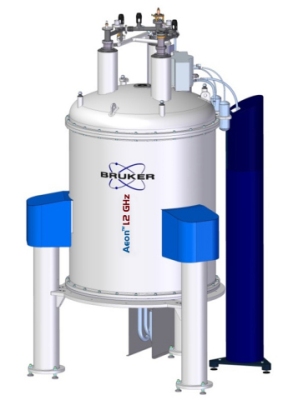Bruker today announced five orders for ultra-high field (UHF) nuclear magnetic resonance (NMR) spectroscopy systems from Europe and Brazil in recent months. These UHF systems have been funded for cutting-edge NMR research in structural biology, intrinsically disordered proteins (IDPs), membrane proteins, macro-molecular complexes and interactions, cell biology, disease research, as well as in advanced materials research.
 Next generation Aeon 1.2 GHz NMR system (Photo: Business Wire).
Next generation Aeon 1.2 GHz NMR system (Photo: Business Wire).
Bruker defines UHF as NMR systems with 1H proton frequency of 900 MHz or above. Other high-field 700, 800 and 850 MHz orders are not included in the UHF definition. The recent UHF NMR orders include three 900 and 950 MHz systems from Brazil, Switzerland and the UK, with revenue typically within 18 months from order:
- The Federal University of Rio de Janeiro (UFRJ) in Brazil is expanding its existing structural biology facility with the addition of a 900 MHz NMR spectrometer. As one of the leading universities in South America, the new 900 MHz system will be available as a regional resource for research in protein structure and dynamics, protein folding and structure of nucleic acids. Professor Fabio C. L. Almeida of UFRJ commented: "Having a 900 MHz will have a strong impact on the development of NMR and structural biology in Brazil and Latin America. It will offer us advantages and capabilities over other techniques in tackling important biological and technological problems."
- The École Polytechnique Féderale de Lausanne (EPFL) in Switzerland has ordered a Bruker 900 MHz instrument with the highest field wide-bore (89 mm inner diameter) magnet currently available for solid-state NMR. It will enable EPFL researchers to tackle problems in complex systems such as enzymes, catalytic nanoparticles, active pharmaceutical ingredients and live model organisms.
- The University of Leeds in the UK is expanding its Astbury Centre for Structural Molecular Biology with a 950 MHz NMR equipped with a novel CryoProbe that is now designed for both 13C and 15N direct detection, besides traditional 1H indirect detection. This technology makes the instrument suitable for determining structures, dynamics and interactions of globular proteins, as well as for advanced functional and disease mechanism studies of intrinsically disordered proteins (IDPs). Professor Alex Breeze at the University of Leeds stated: “We are tremendously excited to be installing our new 950 MHz instrument, which will complement our investment in cutting-edge cryo-electron microscopy and other structural techniques. In particular, the combination of 950 MHz field strength and the novel direct-detection and low-volume capabilities of the latest CryoProbes will allow us to access critical structural and dynamic information on important biological systems and medically relevant targets with the optimum sensitivity and resolution.”
In 2015, Bruker also has received two additional orders for next-generation GHz-class systems from France and Germany, and Bruker’s backlog for GHz-class NMR systems has now increased to nine (9) systems for different European and Canadian customers. Bruker expects to begin to recognize revenues from next-generation Aeon™ 1.0 GHz systems in 2016. The Aeon 1.2 GHz systems backlog is projected to ship over several years, starting in late 2017 or 2018. Revenue timing for future 1.2 GHz systems has inherent risks, and depends on further progress in high-temperature superconductor (HTS) materials and HTS-based NMR magnet technology.
- A 1.2 GHz instrument ordered by the CNRS is expected to be placed at the University of Lille in France and will be available to the French and European scientific community through the NMR Large Scale Facility, hosted by the Centre National de la Recherche Scientifique (CNRS). Dr. Jean-Pierre Simorre, Director of the Large Scale Facility, explained: “The acquisition of this 1.2 GHz spectrometer will keep France at the leading edge of NMR technology. This national instrument will be installed in Lille for a broad panel of interdisciplinary research areas ranging from structural biology to catalysis, from sustainable energy development to bio-medical applications.”
- The Center for Biomolecular Magnetic Resonance (BMRZ) at the Goethe University in Frankfurt, Germany is part of the European Large Scale Facilities and incorporates various high-field liquid and solid-state NMR spectrometers, as well as DNP-NMR and EPR instrumentation. The 1.2 GHz NMR ordered recently is expected to be available to the scientific community in Germany and Europe. Research at the BMRZ is dedicated to the elucidation of structure and functional mechanisms of biomolecules ranging from RNA and RNA-protein complexes, via large protein complexes to membrane proteins. Professor Harald Schwalbe from the BMRZ remarked: "We are very happy to have placed the order for the next generation of NMR. The 1.2 GHz NMR system will allow us to investigate structure, dynamics and biological function of increasingly large and challenging biomolecular complexes. We will also be able to provide access for European researchers."